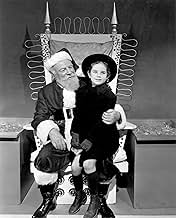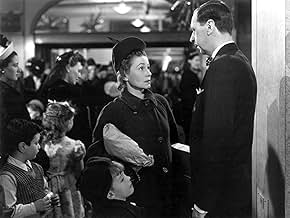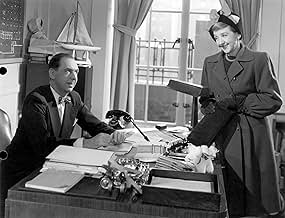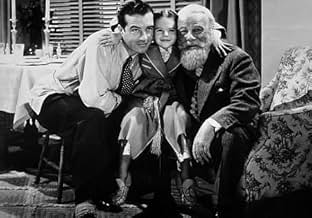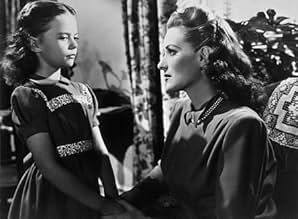Un anciano contratado para hacer de Papá Noel en unos grandes almacenes afirma ser el verdadero Santa Claus. Cuando se cuestiona su cordura, un abogado lo defiende ante el tribunal argumenta... Leer todoUn anciano contratado para hacer de Papá Noel en unos grandes almacenes afirma ser el verdadero Santa Claus. Cuando se cuestiona su cordura, un abogado lo defiende ante el tribunal argumentando que no se equivoca.Un anciano contratado para hacer de Papá Noel en unos grandes almacenes afirma ser el verdadero Santa Claus. Cuando se cuestiona su cordura, un abogado lo defiende ante el tribunal argumentando que no se equivoca.
- Dirección
- Guión
- Reparto principal
- Ganó 3 premios Óscar
- 10 premios y 1 nominación en total
- Post Office Mail Sorter Next to Lou
- (sin acreditar)
- Mr. R.H. Macy
- (sin acreditar)
- Courtroom Spectator
- (sin acreditar)
- Mrs. Shellhammer
- (sin acreditar)
- Courtroom Spectator
- (sin acreditar)
- Judge's Clerk
- (sin acreditar)
- Child on Santa's Lap
- (sin acreditar)
- Secretary
- (sin acreditar)
- Department Store Head
- (sin acreditar)
Reseñas destacadas
Mrs. Walker is working, single mother, who works for Macy's Department Store in New York City. Natalie Wood plays her daughter, Susan. As the result of a failed Marriage, Doris raises her daughter to accept reality. There is no room for fantasy or make believe in her life. Susan is a quiet, child who acts more like a grown up than a 6 year old. She has difficulty using her imagination, and has become just as skeptical as her mother.
Since Kris, believes that "the important thing is to make children happy," winning the affection of Susan and her mother is his main objective.
Whether or not Kris is the real Santa Claus, there is no doubt that he seem to have an influence on almost everyone he meets--except for Macy's staff psychologist .Mr. Sawyer believes that Kris is delusional, and has him committed to thrown into a mental institution. In order to get out, Kris must face a court hearing, where not only is his sanity questioned, but the state of New York will decide if there really is a Santa Claus. Fred Gailey (played by John Payne) a neighbor of Doris Susan Walker agrees to represent Kris. The predictable end to the story is that Fred and Doris become attracted to each other, and as Fred works hard to secure Kris' freedom, Doris finds herself not only believing in Kris, but also in believing in fantasy.
Maureen O'Hara portrays Doris Walker with poise and sophistication. Although the movie is over 55 years old, the idea of a single working mom trying to raise her daughter after a bitter divorce, tells a story that is relevant by today's standards. Natalie Wood does such a good job at playing as the bright six year old, Susan, that you can almost imagine her going straight from being a baby to being an adult. John Payne, as Fred Gailey, predictably plays the handsome attorney who falls in love with Mrs. Walker. Even though it seems a bit unbelievable, this movie is all about fantasy, so we'll allow a bit of romance. Finally, Edmund Gwenn's portrayal of Santa Claus is so believable, that you almost believe that truly is the jolly old elf himself!
This reviewer would give the movie a 5 out of 5 rating. It is a Christmas classic that will be remembered for years to come as one of the best Christmas movies ever filmed. The message of the movie is not about the real meaning of Christmas, nor is it about the commercialism that has overshadowed the holiday for years. The message of the movie is that make believe and fantasy play an important role in our live. Without them we would have no basis for our hopes and dreams
Gwenn, who played many solid character roles, gets the chance here to play a role for which he was ideally suited, and it works very well. O'Hara and Wood make a good pair to balance him out. The supporting cast gets some very good moments of their own, especially Gene Lockhart and William Frawley, whose scenes are entertaining while also offering some occasionally pointed commentary.
The style of the production is well-suited to the material, offering an innocently upbeat story without overdoing it on sentimentality. For all that this style of the production and acting are out of fashion, they are able to capture a theme like this in a worthwhile way that is simply not possible with the kind of false "sophistication" that permeates so many present-day movies.
That's not to say that this is some kind of masterpiece, which it is not and did not try to be. Instead, it's a light, enjoyable, positive movie that does make a worthwhile point or two. That kind of feature will always find an appreciative audience somewhere.
I love movies like this for the insight they provide into the customs of a lost era. Watch the clothing - everybody is so dressed up! - women in dresses, gloves, and hats, men in hats and suits. Notice that when O'Hara enters a room filled with Macy's executives, even though they are the bosses and she is lower management, they all stand up instantly.
The social satire, most on display in the courtroom scenes, also is very 1940s. Apparently audiences of that era took a kind of genial corruption in the judicial system in stride. Business leaders, like "Mr. Macy" were expected to be sharp and profit-oriented, but also decent people like the rest of us. It's a much more nuanced view than the "businessman as criminal villain" so common in today's movies.
The character played by Maureen O'Hara probably needs explanation for modern viewers. Late 1940s audiences knew that the social and economic situation of a divorced working woman with a child was much more precarious than it is now. Divorce was still somewhat shocking - this is brought out neatly in the movie when her would-be lover does a double take when he learns from her daughter about the divorce - he probably had assumed she was a war widow. Divorced moms were still rare in the middle classes. Society universally agreed that women should stay home to raise their children. Economically, women in management positions were still very rare, couldn't expect promotion, and were last hired, first fired. I think O'Hara's performance brings out these qualities in a way that the audience of the 1940s would have understood easily. The character's stiffness, fear of losing control, and anxiety about her job make a great deal of sense. It would have been nice to see a few scenes showing her loosening up, perhaps at dinner with her boyfriend; no doubt those got left on the cutting room floor.
I really like the scene where Santa talks to the little Dutch orphan. First, this scene also must have resonated with the audience; in 1947 the western European countries had only started to recover from World War II, and probably many Americans were familiar with the idea of adopting a war orphan, just as many sent CARE packages. Second, by making Santa fluent in Dutch, the writer cleverly left the viewer thinking that hey, he might really be Santa Claus (isn't Santa Claus fluent in all languages)?
Some reviewers don't like the acting and think that modern actors are "better". I think the older actors aren't better or worse, just different. The audiences of the 1940s expected a certain style of acting, and the directors and actors gave that to them. Then as now, Hollywood paid top dollar and got very talented people, but like all of us they were shaped by their own time and place, more particularly the requirement to make movies that audiences would like. Move Maureen O'Hara to 2004, or Tom Cruise to 1947, and you'd see them acting in the style of that decade.
¿Sabías que...?
- CuriosidadesIn the untranslated dialogue with the Dutch girl, Kris asks her what she wants for Christmas. She says she wants nothing, telling him she got her gift by being adopted by her new mother.
- PifiasKris claims that John Quincy Adams' Vice-President was Daniel D. Tompkins; actually, it was John C. Calhoun. Tompkins served under James Monroe from 1817-1825. The confusion likely occurred because Adams was the 6th President, whereas Tompkins was the 6th Vice-President, as Thomas Jefferson and James Madison had three Vice-Presidents between them.
- Citas
Mr. Shellhammer: But... but maybe he's only a little crazy like painters or composers or... or some of those men in Washington.
- Créditos adicionalesThe film's credits do not contain the standard "All characters and events are fictional..." disclaimer, leaving many people to believe that this was a true story.
- Versiones alternativasAlso available in two computer colorized versions. The film was first colorized in 1985 by Color Systems Technology, Inc. and again in 2006 by Legend Films using much-improved technology. Prints came with a disclaimer: "It has been altered without the participation of the principal director, screenwriter and other creators of the original film."
- ConexionesFeatured in The Screen Writer (1950)
- Banda sonoraJingle Bells
(1857) (uncredited)
Written by James Pierpont
Played at the announcement of the parade
Played occasionally in the score
Sung a cappella a bit by Percy Helton and later by Jack Albertson
Selecciones populares
- How long is Miracle on 34th Street?Con tecnología de Alexa
Detalles
- Fecha de lanzamiento
- País de origen
- Idiomas
- Títulos en diferentes países
- Miracle on 34th Street
- Localizaciones del rodaje
- 24 Derby Road, Port Washington, Long Island, Nueva York, Estados Unidos(Susan's dream house)
- Empresa productora
- Ver más compañías en los créditos en IMDbPro
Taquilla
- Recaudación en todo el mundo
- 3851 US$
- Duración1 hora 36 minutos
- Color
- Relación de aspecto
- 1.37 : 1
Contribuir a esta página







